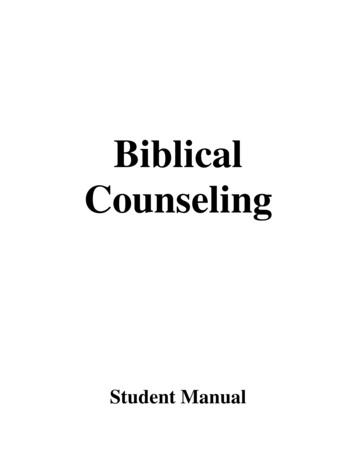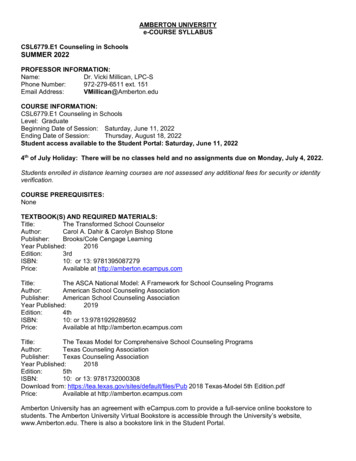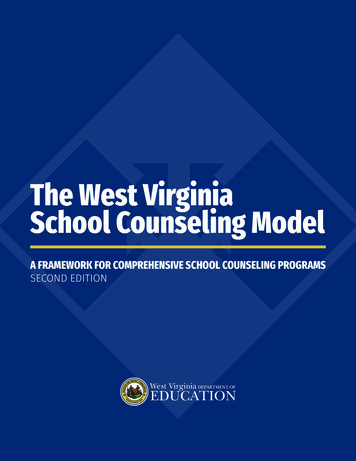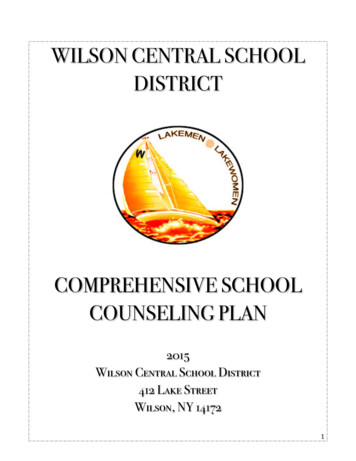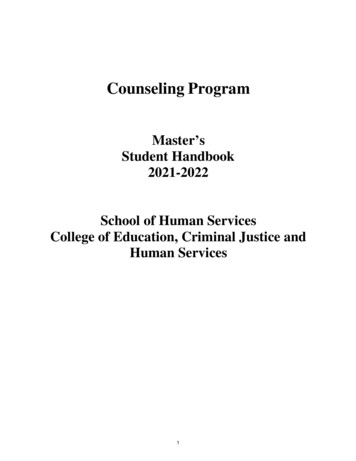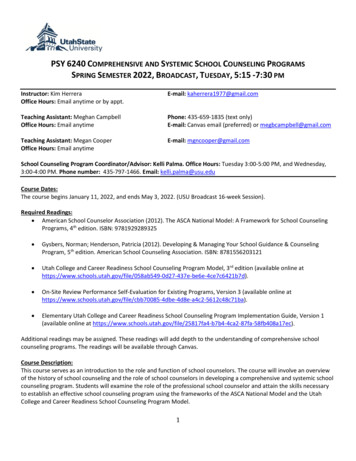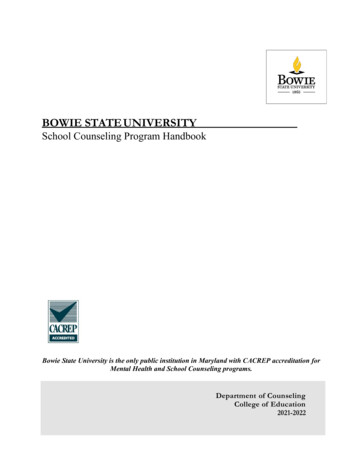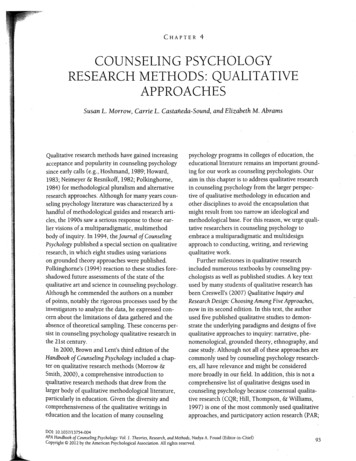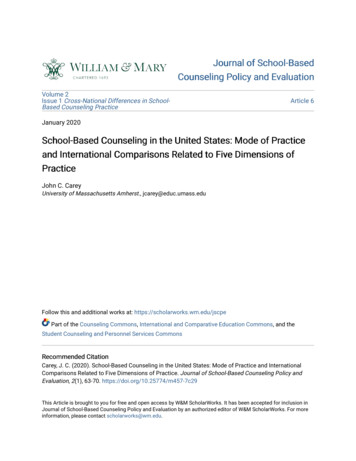
Transcription
Journal of School-BasedCounseling Policy and EvaluationVolume 2Issue 1 Cross-National Differences in SchoolBased Counseling PracticeArticle 6January 2020School-Based Counseling in the United States: Mode of Practiceand International Comparisons Related to Five Dimensions ofPracticeJohn C. CareyUniversity of Massachusetts Amherst., jcarey@educ.umass.eduFollow this and additional works at: https://scholarworks.wm.edu/jscpePart of the Counseling Commons, International and Comparative Education Commons, and theStudent Counseling and Personnel Services CommonsRecommended CitationCarey, J. C. (2020). School-Based Counseling in the United States: Mode of Practice and InternationalComparisons Related to Five Dimensions of Practice. Journal of School-Based Counseling Policy andEvaluation, 2(1), 63-70. https://doi.org/10.25774/m457-7c29This Article is brought to you for free and open access by W&M ScholarWorks. It has been accepted for inclusion inJournal of School-Based Counseling Policy and Evaluation by an authorized editor of W&M ScholarWorks. For moreinformation, please contact scholarworks@wm.edu.
U.S. SCHOOL COUNSELING PRACTICEJournal of School-Based Counseling Policy & EvaluationDOI: 10.25774/m457-7c29School-Based Counseling in the United States: Mode of Practice andInternational Comparisons Related to Five Dimensions of PracticeJohn C. CareyUniversity of Massachusetts, AmherstAbstractThis study used the five dimensions of practice identified byCarey, Fan, He, and Jin (2020) to describe the preferredmode of practice of US school-based counselors andcompare this mode of practice with nine other countries. Atotal of 380 US school counselors completed theInternational Survey of School Counselor Activities-UnitedStates. Mean item ratings and mean BART scores were usedfor both descriptions and comparisons. US counselorsindicated that Counseling Services; Advocacy and SystemicImprovement; Prevention Programs; and, Educational andCareer Planning were all important aspects of their role. Incomparison to international counterparts, US counselorsplaced greater emphasis on Advocacy and SystemicImprovement and Prevention Programs. Results confirmedprevious scholarship suggesting that counselors in the UShave a very broad role. Any reformulation of this role wouldbenefit from comparative international research on thestrengths and limitations of different modes of practice.Keywords: school-based counseling, school counselor role,cross-national comparative research, international schoolcounseling, policy research.School-based counseling in the United States is a matureprofession with well-established modes and standards forpractice. Counselors have been employed in U.S. schoolsfor over 100 years and over that time several shifts in thenature of the work have occurred (Cinotti, 2014; Gysbers,2004). However, several factors have operated to establisha high level of consensus regarding the mode of practice forschool-based counseling in the United States. First, theprofessional associations have developed importantstatements and guidelines regarding the school counselors’role and function. Most notably these include: theAmerican School Counseling Association ([ASCA], 1999)role statement; the current ASCA statements on appropriateand inappropriate school counselor duties (ASCA, n.d.a);school counselor competencies (ASCA, n.d.b); and the roleof the school counselor (ASCA, n.d.c).In addition, comprehensive developmental guidance(CDG) gradually emerged as the dominant model for theorganization and evaluation of school-based counselingprograms and the majority of state departments of educationadopted official models based on its principles (Sink &MacDonald, 1998). CDG specifies a broad role for schoolbased counselors that includes activities related toindividual planning, guidance curriculum, responsiveservices, and system support (Gysbers & Henderson, 2012).The ASCA National Model for School CounselingPrograms (ASCA, 2003, 2012) updated CDG to increase itscompatibility with contemporary models of schooling. Thismodel enumerated many activities that constitute the role ofschool counselors. Martin and Carey’s (2014) analysis ofthe ASCA’s (2012) National Model identified six distinctcategories of school counselor activities related to: directservices (counseling with students), indirect services(consultation and training with teachers and parents), schoolcounselor personnel evaluation, counseling programmanagement, counseling program evaluation, andprofessional advocacy. After the initial development of theASCA National Model (2003), most state departments ofeducation updated their official state models to align themwith the ASCA National Model (Martin, Carey, &DeCoster, 2009).The professional association guidelines on role andfunction and the ASCA National Model influenced theAccreditation Standards of the Council on the Accreditationof Counseling and Related Education Programs([CACREP], 2015). CACREP oversees a voluntary nationalaccreditation process for university-based counselorpreparation programs. As a result, the curriculum oftraining programs seeking CACREP accreditation must bealigned with professional practice as specified in theprofessional guidelines and the ASCA National Model. TheCACREP Accreditation Standards, professional associationguidelines, and state models have influenced in turn: (a)state licensure and certification standards that are used todetermine whether candidates for school counselingpositions in public schools are approved for employmentand practice; and (b) state training program accreditationstandards that influence the curriculum of university-basedtraining programs (Trevisan, Carey, & Martin, in press). Insummary, mutually reinforcing models and standards ofprofessional associations, accrediting bodies and statedepartments of education have led to an increasing level ofconsensus on the mode of practice for school-basedcounselors in the United States.That said, scholars have noted that there is still not aperfect consensus on the ideal mode of school-basedpractice (Cinotti, 2014; Lambie & Williamson, 2004).Whether school-based counselors should offer mentalhealth counseling services to needy students or restrictthemselves to engaging in the referral and monitoring ofstudents with mental health problems is a particularlyCarey (2020), 63
U.S. SCHOOL COUNSELING PRACTICEJournal of School-Based Counseling Policy & EvaluationVolume 2(1)troublesome question related to the professional role(Christian & Brown, 2018). It has been suggested that theprofessional identity of school-based counselors mayinfluence the extent to which they engage in the actualdelivery of mental health counseling with students vs.handling students’ mental health issues through referral(Kaplan & Gladding, 2011).Research has also consistently demonstrated that eventhough school-based counselors in the United States mayhave achieved a reasonable consensus on their role andassociated activities, school administrators, teachers andparents may not necessarily understand or share thisperspective (e.g., Reiner, Colbert, & Perusse, 2009; Wilder& Ray, 2013; Zalaquett, & Chatters, 2012). Many U.S.school-based counselors may be limited in the extent towhich they can enact their ideal role because criticalstakeholders have different expectations for them (Culbreth,Scarborough, Banks-Johnson, & Solomon, 2005; Nelson,Robles-Pina, & Nichter, 2008; Scarborough, & Culbreth,2008).In addition, several important critiques of the currentU.S. school-based counseling mode of practice should benoted. It has been suggested that the role of U.S. schoolbased counselors is so broad that it is impossible to enactthe full range of prescribed activities with high quality(Carey & Martin, 2017; College Board, 2011). In addition,Astramovich, Hoskins, and Bartlett (2010) have suggestedthat many of the tasks associated with this broad role do notrequire a high level of professional training and that studentsare best served when school-based counselors are free tofocus on the delivery of direct counseling services.Suggestions to revise the U.S. school-based mode ofpractice have included: eliminating activities considered tobe extraneous by aligning university training with actualschool-based counseling practice (College Board, 2011),using paraprofessionals to perform activities that do notrequire advanced counselor training (Astramovich et al.,2010), and developing school-based counselingspecializations to enable schools to create teams ofcounselors with the expertise that they need (Carey &Martin, 2017).Recent studies using the International Survey of SchoolCounselor Activities (ISSCA) contributed to theunderstanding of the current mode of practice in the UnitedStates. In a recent study, Fan, Carey, He, and Martin (2019)found that there was a great deal of consensus among theparticipants from a national sample of U.S. school-basedcounselors regarding the importance of the various activitiesincluded in the survey. U.S. school-based counselorsshowed very few practically significant, demographicdifferences in role perceptions. Interestingly, counselors’professional identity did not seem to be strongly related totheir perspectives on role. These results were replicated ina follow-up study of school-based counselors in WestVirginia (He, Brady, & Carey, in press).The international comparative study of schoolcounseling practice has the potential to offer interesting andimportant insights into the efficacy of different modes ofpractice (Aluede, Carey, Harris, & Lee, 2017). The ISSCAwas designed to enable such international comparisons. Inthe lead article of this special issue, Carey, Fan, He, and Jin(2020) presented the results of a ten-nation comparativestudy of the mode of practice of school-based counselors.This study found that there are at least five importantdimensions along which school-based counseling practicediffers across countries: Counseling Services; Advocacy rator Role; and, Educational and Career Planning.The purposes of the present study were: (a) to describe thepreferred mode of practice of U.S. school-based counselorsbased on these five dimensions; and (b) to contrast the U.S.mode of practice with that of the other nine nations.MethodThe methods of data collection for the present study havebeen described in detail by Fan, et al. (2019). A briefsynopsis is presented below.MeasureParticipants completed the United States version of theInternational Survey of School Counselors’ Activities(ISSCA-US; Fan et al., 2019)ParticipantsData were collected from two different samples. For thefirst sample, the American Counseling Association (ACA)provided emails for members who had indicated that theywere employed as school counselors and who had givenpermission to be contacted for research purposes (N 2,137). Of this group, 403 people returned surveys, 219 ofwhich completed the entire 42-item ISSCA-US. A secondsample was drawn from a state department of educationlist of 815 school counselors in West Virginia. Of thisgroup, 236 people returned surveys, 171 of who completedthe entire 42-item ISSCA-US. In all, 390 U.S. school-basedcounselors contributed data to this study.ProceduresThe ISSCA-US and all research materials and procedureswere reviewed and approved by the University ofMassachusetts Human Subjects UMASS InstitutionalReview Board prior to study implementation. A surveywas built in Survey Monkey that included an InformedConsent page, demographic items, and the 42-item ISSCAUS. A link to the online survey was sent out to participantsin January 2017 in an email from the first author thatinformed them of the purposes of the research, the natureof the ISSCA-US, the potential impact their participationcould have on policy research, and the confidentiality oftheir responses. The link led to an Informed Consent page.Carey (2020), 64
U.S. SCHOOL COUNSELING PRACTICEJournal of School-Based Counseling Policy & EvaluationVolume 2(1)If participants agreed to participate, they were directed tothe demographic items and ISSCA-US. After the initialrequest, two reminders were also sent out at one-weekintervals to participants who had not yet responded to theInformed Consent request.Data AnalysisData analysis procedures were described by Carey et al.(2020). The data from U.S. school counselors was pooledwith data from counselors in 9 other countries andsubjected to an exploratory factor analysis. Fivedimensions of practice were identified. Mean item ratingsand mean BART scores were also computed to providedescriptive information on U.S. ratings and permitinternational comparisons on these five dimensions.ResultsU.S. School Counselor Ratings of AppropriatenessAverage item ratings by U.S. school counselors on the fivedimensions of practice are resented in Table 1. U.S.school counselors rated four dimensions of practice veryhighly: Counseling Services (M 3.5; SD 0.40);Advocacy and Systemic Improvement (M 3.5; SD 0.42); Prevention Programs (M 3.4 SD 0.45); andEducational and Career Planning (M 3.5; SD 0.58).Considering the anchoring of the ratings (3 “Appropriate”; 4 “Very Appropriate”) this indicated thatU.S. school counselors consider all four of thesedimensions of practice as being very appropriate. U.S.school counselors rated the Administrator Role dimension(M 2.0; SD 0.5) as being inappropriate for theprofessional school counselor role in the United States.BART Scores for U.S. School Counselor RatingsResponse RatesIn order to increase the number of respondents, the tailoreddesign method for electronic surveying methods was usedin regard to email communications and the timing ofdelivery (Dillman, Smyth, & Christian, 2014). Out of apossible 2,952 participants who were invited to completethe research instrument, 390 complete data sets wereobtained. This represents an overall return rate of 13%, afigure that, while low, is on par with prior survey researchinvolving school counselor populations (Limberg, Lambie,& Robinson, 2016; McCabe, Rubinson, Dragowski, &Elizalde-Utnick, 2013; Mullen, Lambie, Griffith, &Sherrell, 2015). While internal online surveys withinorganizations (e.g., places of employment or universitysystems) tend to have an average response rate of 30-35%(Baruch & Holtom, 2008; Nulty, 2008), survey responserates among large, external populations typically fallbetween 10-15% (Fan & Yan, 2010). A low responselimits the generalizability of findings and may reflect nonresponse bias, though Cook et al. (2000) argue that insurvey research, population representativeness isultimately more essential than response rate.Participant CharacteristicsAmong the participants: 17% were male and 83% werefemale; 43.1% worked in a Rural setting, 34.1% in aSuburban setting, 17.7% in an Urban setting, and 4.6% inan Inner City setting. Their experience of working as aschool counselor ranged from 1 to 40 years with 23%reporting as less or equal to 4 years, 22% (5-9 years), 16%(10-14 years), 21% (15-19 years), and 18% (20 years).With regard to the grade levels with which they worked,25% of the participants indicated working at theelementary level, 18% at middle school level, 37% at highschool level, and 20% at the other overlapped grade levels.Average BART scores of the ratings of U.S. schoolcounselors and their international counterparts on the fivedimensions of practice are presented in Table 2. Comparedto their counterparts in 9 other countries, U.S. schoolcounselors showed: the highest average BART score forthe Advocacy and Systemic Improvement dimension (M 0.643; SD 0.632) and the third highest average BARTscore for Prevention Programs (M 0.688; SD 0.648).Compared to the United States, only Turkey and Nigeriashowed a greater emphasis on Prevention Programs. TheUnited States approach to practice can be considered toshow a strong emphasis on these two dimensions incomparison to the international sample as a whole.In contrast, U.S. school counselors showed the lowestaverage BART score for the Administrator Role dimension(M -0.959; SD 0.930) out of all the 10 countriessampled. The U.S. approach to practice does not includeactivities associated with school administrative functions.For Educational and Career Planning, the U.S. BARTscore was the 5th highest (M 0.494; SD 0.900).Similarly, for Counseling Services, the U.S. BART scorewas the 6th highest (M -.347; SD 0.976). In comparisonto the other 9 countries, the U.S. approach to practice is inthe middle on both these dimensions. It should be notedthat U.S. counselors considered both of these dimensionsas very important aspects of professional practice.However, comparatively, the approaches to schoolcounseling practice in approximately half of the othercountries sampled showed a greater emphasis on these twodimensions.DiscussionThe results of the present study confirm previousscholarship (Carey & Martin, 2017; College Board, 2011)that suggested that school-based counselors in the UnitedStates have a broad role. U.S. school-based counselorsindicated that activities related to Counseling Services(e.g., student individual counseling, student groupCarey (2020), 65
U.S. SCHOOL COUNSELING PRACTICEJournal of School-Based Counseling Policy & EvaluationVolume 2(1)counseling, parent consultation); Advocacy and SystemicImprovement (e.g., advocating for the needs of individualstudents and for improvements in school policies andprocedures); Prevention Programs (e.g., guidancecurriculum and prevention program delivery) and,Educational and Career Planning (e.g., career awarenessgroups, career counseling, and college placementcounseling) were all important aspects of the schoolcounseling role. Furthermore, in internationalcomparisons, U.S. school-based counselors showed astrong emphasis on the importance of activities related toAdvocacy and Systemic Improvement along withPrevention Program. Their emphasis on CounselingServices and Educational and Career Planning proved tobe near the midpoint of the 10 country sample. Finally,U.S. school-based counselors (along with counselors from8 of the remaining 9 countries) showed a strong consensusthat activities associated with the Administrator Role wereinappropriate for the school counselor role. This resultwould be expected given the United States emphasis oncomprehensive developmental models of practice(including the ASCA National Model) that specify a widerange of types of activities (Martin & Carey, 2014) andprofessional association statements that both suggest abroad range of appropriate activates and indicate thataspects of administrator role are incompatible with theschool counselor role (ASCA, 1999; n.d.a; n.d.c).Other countries participating in this study showed anarrower role. Maltese school-based counselors, forexample, considered Educational and Career Planningactivates as inappropriate for the role. Costa Rican andVenezuelan counselors rated activities related to deliveringPrevention Programs as having relatively little importanceregarding their role. Nigerian counselors rated activitiesrelated to Advocacy and Systemic Improvement as havingrelatively little importance regarding their role.Interestingly, Nigerian counselors also rated activitiesrelated to the Administrator Role as being importantelements of school-based counseling practice. Furthercomparative research is needed to identify the reasons thatmodes of school-based counseling programs differ and toidentify the strengths and limitations associated with thesedifferences.At present we suggest that the reason a broad model ofpractice exists in the United States is because of theconsensus that has developed as a result of (a) defining theschool-based counselor role in terms of comprehensivedevelopmental guidance; and (b) the use of this broaddefinition of role in professional licensure/certificationstatutes, training program accreditation standards, andprofessional role statements. We further suggest that thisbroad role is enabled by the affluence of the United Statesthat allows for both rich staffing of school-basedcounselors in public schools and an extended period ofuniversity training. It is further enabled by a tradition thatvests responsibility for all activities related to the role inthe school-based counselors themselves rather than (as istrue in several other countries) by having differentprofessionals responsible for different sets of activities.While several possible reformulations of role have beensuggested (e.g., Astramovich et al., 2010; Carey & Martin,2017; College Board; 2011), at this point necessary data onthe strengths and limitation of different modes of practiceis sorely lacking. A reformulation of the role of schoolbased counselors in the United States would be greatlyaided by comparative international research. Relatedly, thedebate over how school-based counselors in the UnitedStates should address the mental health issues of studentsneeds to be grounded in research on the strengths andlimitations of different approaches to addressing mentalhealth issues.Author NoteJohn C. Carey, Ronald H. Fredrickson Center for SchoolCounseling Outcome Research and Evaluation (CSCORE),University of Massachusetts, Amherst. Correspondenceconcerning this article should be addressed to John C. Carey,Fredrickson Center for School Counseling OutcomeResearch and Evaluation (CSCORE), University .umass.edu).ReferencesAluede, O., Carey, J. C., Harris, B., & Lee, S. M. (2017).Present status and future directions for policyresearch and evaluation in school-based counseling.In Carey, J.C., Harris, B., Lee, S.M, & Aluede, O.(Eds.) International handbook for policy research inschool-based counseling. New York: Springer.American School Counselor Association (2012). TheASCA national model: A framework for schoolcounseling programs (3rd ed.). Alexandria, VA:Author.American School Counselor Association. (2003). TheASCA national model: A framework for schoolcounseling programs. Alexandria, VA: Author.American School Counselor Association. (1999). Role ofthe school counselor. Alexandria, VA: Author.American School Counselor Association. (n.d.a).Appropriate activities of school counselors.Retrieved from https://www.schoolcounselor.org/asca/media/ rs.pdfAmerican School Counselor Association. (n.d.b). ASCAschool counselor competencies. Retrieved fromhttps://www.schoolcounselor.orgAmerican School Counselor Association. (n.d.c). Role ofthe school counselor. Retrieved a/home/RoleStatement.pdfCarey (2020), 66
U.S. SCHOOL COUNSELING PRACTICEJournal of School-Based Counseling Policy & EvaluationVolume 2(1)Astramovich, R. L., Hoskins, W. J., & Bartlett, K. A.(2010). Rethinking the organization and delivery ofcounseling in schools. Retrieved 0/Article78.pdfBaruch, Y., & Holtom, B. C. (2008). Survey response ratelevels and trends in organizational research. HumanRelations, 61, Carey, J. C., Fan, K. Y., He, L., & Jin, Y. Y. (2020). Fivedimensions of school-based counseling practice:Factor analysis identification using the internationalsurvey of school counselors’ activities. Journal ofSchool-based Counseling Policy and Evaluation,2(1), 4-21. https://doi.org/10.25774/0rpq-0v54Carey J. C. & Martin, I. (2017). Policy research on schoolbased counseling in the United States: Establishing apolicy research agenda. In Carey, J.C., Harris, B.,Lee, S.M., & Aluede, O. (Eds.). Internationalhandbook for policy research in school-basedcounseling. New York: Springer.Christian, D. D., & Brown, C. L. (2018).Recommendations for the Role and Responsibilitiesof School-Based Mental Health Counselors. Journalof School-Based Counseling Policy and Evaluation,1, 26-39. https://doi.org/10.25774/nmfk-y245Cinotti, D. (2014). Competing professional identitymodels in school counseling: A historical perspectiveand commentary. The Professional Counselor, 4,417–425. https://doi.org/10.15241/dc.4.5.417College Board. (2011). School counselors: literature andlandscape review. The state of school counseling inAmerica. Civic Enterprises.Cook C., Heath F., & Thompson R.L. (2000). A metaanalysis of response rates in web- or internet-basedsurveys. Educational and PsychologicalMeasurement, 60, Council for Accreditation of Counseling and RelatedEducational Programs. (2015). 2016 CACREPStandards. Retrieved 0/2016-CACREPStandards.pdfCulbreth, J. R., Scarborough, J. L., Banks-Johnson, A., &Solomon, S. M. (2005). Role stress among schoolcounselors. Counselor Education and Supervision,45, 58-71. illman, D. A., Smyth, J. D., & Christian, L. M. (2014).Internet, mail, and mixed-mode surveys: The tailoreddesign method. Hoboken, N.J: Wiley & Sons.Fan, K. U., Carey, J. C., He, L, & Martin, I. (2019).Activities and role of school counselors in the UnitedStates: A national survey of ACA members who areschool counselors. Journal of School-BasedCounseling Policy and Evaluation, 1, 34-50.https://doi.org/10.25774/8nz2-4y62Fan, K. U., Carey, J. C., Thomas, E., Griffith, C., Wells,C., He, L. & Niu, J. (2019). Development andexploratory factor analysis of the United Statesversion of the International Survey of SchoolCounselors’ Activities. International Journal for theAdvancement of Counseling, 41, 339-360.https://doi.org/10.25774/8nz2-4y62Fan, W., & Yan, Z. (2010). Factors affecting responserates of the web survey: A systematic review.Computers in Human Behavior, 26, ysbers, N. C. (2004). Comprehensive guidance andcounseling programs: The evolution ofaccountability. Professional School Counseling, 8, 114.Gysbers, N. C., & Henderson, P. (2012). Developing andmanaging your school guidance program (5th ed.).Alexandria, VA: American Counseling Association.He, L., Brady, B., Carey, J. C. (in press). Activities androle of school-based counselors in West Virginia: Acomparison to a national sample of schoolcounselors. Journal of School-Based CounselingPolicy and Evaluation.Kaplan, D. M., & Gladding, S. T. (2011). A vision for thefuture of counseling: The 20/20 principles forunifying and strengthening the profession. Journal ofCounseling and Development, 89, b00101.xLambie, G. W., & Williamson, L. L. (2004). The challengeto change from guidance counseling to professionalschool counseling: A historical proposition.Professional School Counseling, 8, 124–131.Limberg, D., Lambie, G., & Robinson, E. H. (2016). Thecontribution of school counselors' altruism to theirdegree of burnout. Professional School Counseling,20, 127-138. https://doi.org/10.5330/1096-240920.1.127Martin, I. & Carey, J. C. (2014). Development of a logicmodel to guide evaluations of the ASCA NationalModel for School Counseling Programs. TheProfessional Counselor Journal, 4, 455-466.https://doi.org/10.15241/im.4.5.455Martin, I., Carey, J., & DeCoster, K. (2009). A nationalstudy of the current status of state school counselingmodels. Professional School Counseling, 12(5), 378386. https://doi.org/10.1177/2156759X0901200506McCabe, P. C., Rubinson, F., Dragowski, E. A., &Elizalde-Utnick, G. (2013). Behavioral intention ofteachers, school psychologists, and counselors tointervene and prevent harassment of LGBTQ youth.Carey (2020), 67
U.S. SCHOOL COUNSELING PRACTICEJournal of School-Based Counseling Policy & EvaluationVolume 2(1)Psychology in the Schools, 50, 672-688.https://doi.org/10.1002/pits.21702Mullen, P. R., Lambie, G. W., Griffith, C., & Sherrell, R,(2015). School counselors’ general self-efficacy,ethical and legal self-efficacy, and ethical and legalknowledge. Ethics & Behavior, Nelson, J. A., Robles-Pina, R. & Nichter, M. (2008). Ananalysis of Texas high school counselors' roles:Actual and preferred counseling activities. Journal ofProfessional Counseling: Practice, Theory, andResearch, 36, 42Nulty, D. D. (2008). The adequacy of response rates toonline and paper surveys: What can be done?.Assessment & Evaluation in Higher Education, 31Reiner, S. M., Colbert, R. D., & Perusse, R. (2009).Teacher perceptions of the professional schoolcounselor role: A national study. Professional SchoolCounseling, 12, Scarborough, J. L., & Culbreth, J. R. (2008). Examiningdiscrepancies between actual and preferred practiceof school counselors. Journal of Counseling andDevelopment, 86, b00533.xSink, C. A., & MacDonald, G. (1998). The status ofcomprehensive guidance and counseling in theUnited States. Professional School Counseling, 2, 8894.Trevisan, M. S., Carey, J. C., & Martin, I. (in press).School counselor state licensure requirements andprofessional accreditation standards in programevaluation. Journal of School-Based CounselingPolicy and Evaluation.Wilder, C. & Ray, D. (2013). Parent preferences forsecondary school counselor activities. Journal ofProfessional Counseling, Practice, Theory, &Research, 40, 20Zalaquett, C. P., & Chatters, S. J. (2012). Middle schoolprincipals’ perceptions of middle school counselors’roles and functions. American Secondary Education,40, 89-103.Carey (2020), 68
U.S. SCHOOL COUNSELING PRACTICEJournal of School-Based Counseling Policy & EvaluationVolume 2(1)Table 1.Means and standard deviation for items for five dimensions of practice for ten countriesAdvocacy andCounselingSystemicPr
statements and guidelines regarding the school counselors' role and function. Most notably these include: the American School Counseling Association ([ASCA], 1999) role statement; the current ASCA statements on appropriate and inappropriate school counselor duties (ASCA, n.d.a); school counselor competencies (ASCA, n.d.b); and the role


